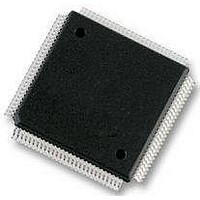MC9S12E128CPV Freescale Semiconductor, MC9S12E128CPV Datasheet - Page 534

MC9S12E128CPV
Manufacturer Part Number
MC9S12E128CPV
Description
Microcontrollers (MCU) 16 Bit 16MHz
Manufacturer
Freescale Semiconductor
Datasheet
1.MC9S12E128CPV.pdf
(606 pages)
Specifications of MC9S12E128CPV
Data Bus Width
16 bit
Program Memory Type
Flash
Program Memory Size
128 KB
Data Ram Size
8 KB
Interface Type
SCI, SPI
Maximum Clock Frequency
25 MHz
Number Of Programmable I/os
92
Number Of Timers
16 bit
Operating Supply Voltage
3.135 V to 5.5 V
Maximum Operating Temperature
+ 85 C
Mounting Style
SMD/SMT
Package / Case
LQFP-112
Minimum Operating Temperature
- 40 C
On-chip Adc
10 bit
On-chip Dac
8 bit, 2 Channel
Lead Free Status / Rohs Status
No RoHS Version Available
Available stocks
Company
Part Number
Manufacturer
Quantity
Price
Company:
Part Number:
MC9S12E128CPVE
Manufacturer:
Freescale Semiconductor
Quantity:
10 000
- Current page: 534 of 606
- Download datasheet (4Mb)
Chapter 18 Multiplexed External Bus Interface (MEBIV3)
18.3.2.15 Port K Data Register (PORTK)
Read: Anytime
Write: Anytime
This port is associated with the internal memory expansion emulation pins. When the port is not enabled
to emulate the internal memory expansion, the port pins are used as general-purpose I/O. When port K is
operating as a general-purpose I/O port, DDRK determines the primary direction for each port K pin. A 1
causes the associated port pin to be an output and a 0 causes the associated pin to be a high-impedance
input. The value in a DDR bit also affects the source of data for reads of the corresponding PORTK register.
If the DDR bit is 0 (input) the buffered pin input is read. If the DDR bit is 1 (output) the output of the port
data register is read.
This register is not in the map in peripheral or expanded modes while the EMK control bit in MODE
register is set. Therefore, these accesses will be echoed externally.
When inputs, these pins can be selected to be high impedance or pulled up, based upon the state of the
PUPKE bit in the PUCR register.
534
Pin Function
Port K, Bits 5:0
Port K, Bit 7
Port K, Bit 6
Alternate
Field
5:0
Reset
7
6
W
R
Port K, Bit 7 — This bit is used as an emulation chip select signal for the emulation of the internal memory
expansion, or as general-purpose I/O, depending upon the state of the EMK bit in the MODE register. While
this bit is used as a chip select, the external bit will return to its de-asserted state (V
cycle just after the negative edge of ECLK, unless the external access is stretched and ECLK is free-running
(ESTR bit in EBICTL = 0). See the MMC block description chapter for additional details on when this signal
will be active.
Port K, Bit 6 — This bit is used as an external chip select signal for most external accesses that are not
selected by ECS (see the MMC block description chapter for more details), depending upon the state the of
the EMK bit in the MODE register. While this bit is used as a chip select, the external pin will return to its de-
asserted state (V
access is stretched and ECLK is free-running (ESTR bit in EBICTL = 0).
Port K, Bits 5:0 — These six bits are used to determine which FLASH/ROM or external memory array page
is being accessed. They can be viewed as expanded addresses XAB19–XAB14 of the 20-bit address used to
access up to1M byte internal FLASH/ROM or external memory array. Alternatively, these bits can be used for
general-purpose I/O depending upon the state of the EMK bit in the MODE register.
Bit 7
ECS
0
7
XCS
6
0
6
DD
) for approximately 1/4 cycle just after the negative edge of ECLK, unless the external
Figure 18-19. Port K Data Register (PORTK)
Table 18-13. PORTK Field Descriptions
MC9S12E128 Data Sheet, Rev. 1.07
XAB19
5
0
5
XAB18
4
0
4
Description
XAB17
3
3
0
XAB16
2
2
0
DD
Freescale Semiconductor
XAB15
) for approximately 1/4
1
0
1
XAB14
Bit 0
0
0
Related parts for MC9S12E128CPV
Image
Part Number
Description
Manufacturer
Datasheet
Request
R
Part Number:
Description:
Manufacturer:
Freescale Semiconductor, Inc
Datasheet:
Part Number:
Description:
Manufacturer:
Freescale Semiconductor, Inc
Datasheet:
Part Number:
Description:
Manufacturer:
Freescale Semiconductor, Inc
Datasheet:
Part Number:
Description:
Manufacturer:
Freescale Semiconductor, Inc
Datasheet:
Part Number:
Description:
Manufacturer:
Freescale Semiconductor, Inc
Datasheet:
Part Number:
Description:
Manufacturer:
Freescale Semiconductor, Inc
Datasheet:
Part Number:
Description:
Manufacturer:
Freescale Semiconductor, Inc
Datasheet:
Part Number:
Description:
Manufacturer:
Freescale Semiconductor, Inc
Datasheet:
Part Number:
Description:
Manufacturer:
Freescale Semiconductor, Inc
Datasheet:
Part Number:
Description:
Manufacturer:
Freescale Semiconductor, Inc
Datasheet:
Part Number:
Description:
Manufacturer:
Freescale Semiconductor, Inc
Datasheet:
Part Number:
Description:
Manufacturer:
Freescale Semiconductor, Inc
Datasheet:
Part Number:
Description:
Manufacturer:
Freescale Semiconductor, Inc
Datasheet:
Part Number:
Description:
Manufacturer:
Freescale Semiconductor, Inc
Datasheet:
Part Number:
Description:
Manufacturer:
Freescale Semiconductor, Inc
Datasheet:











